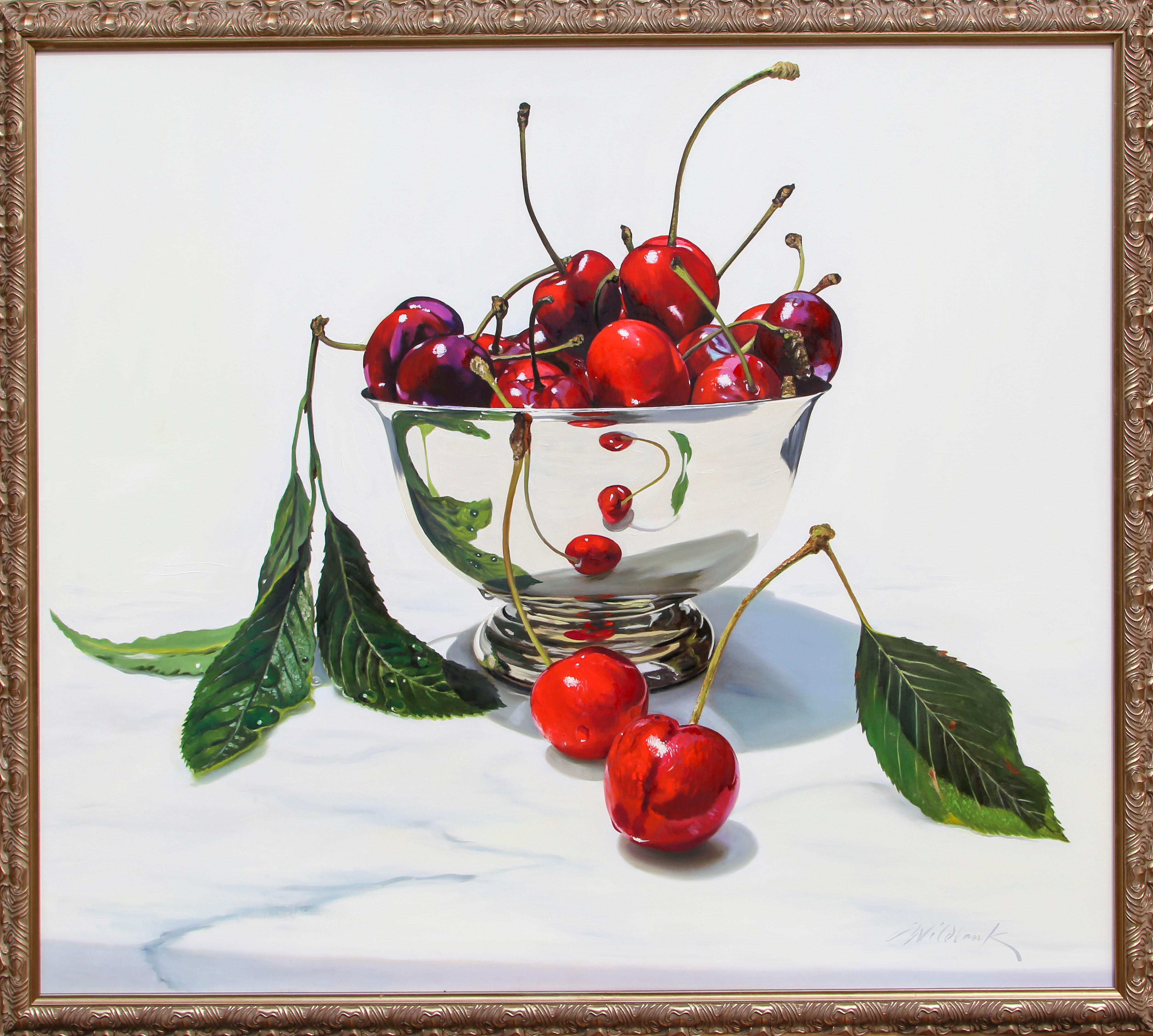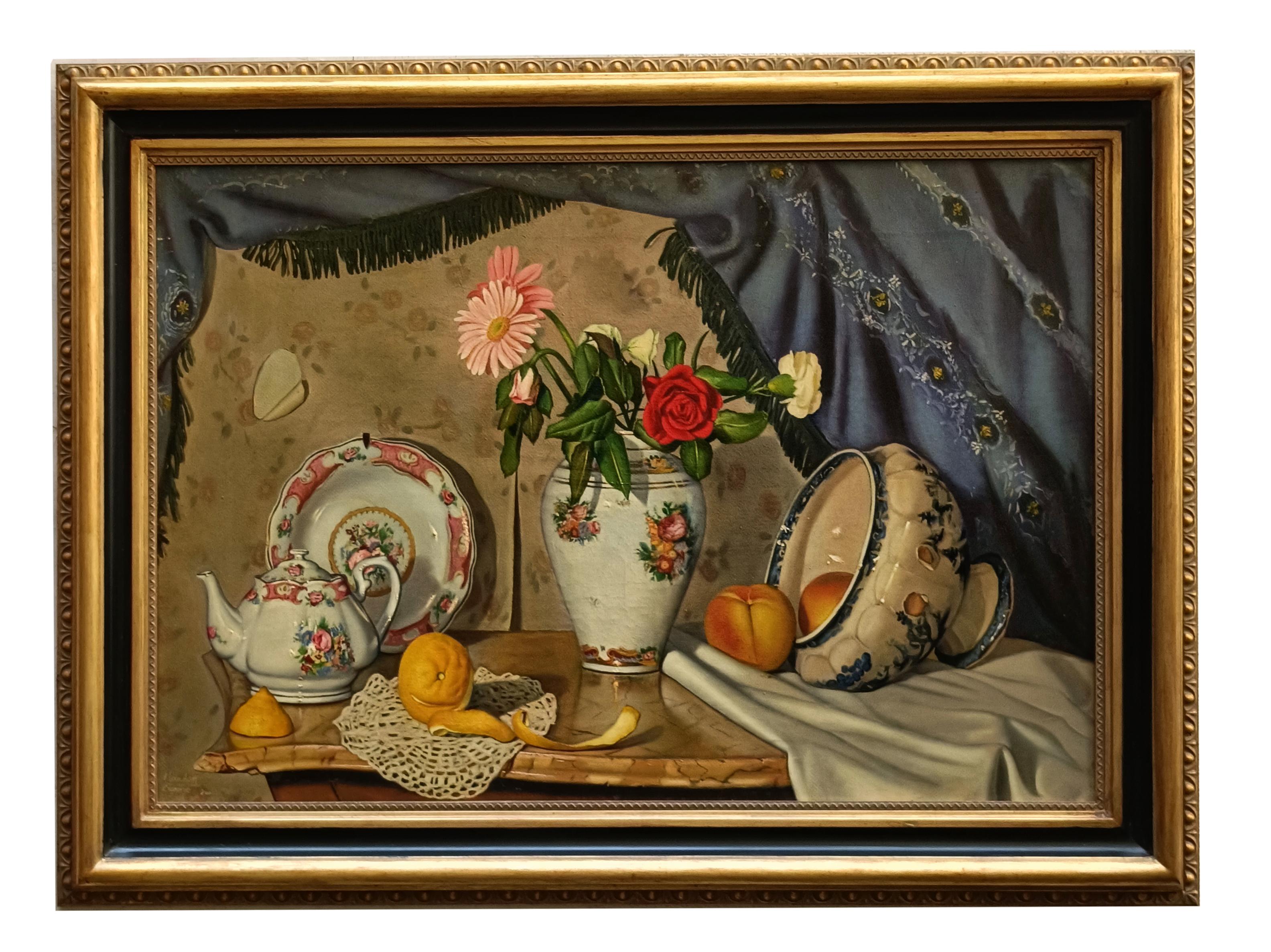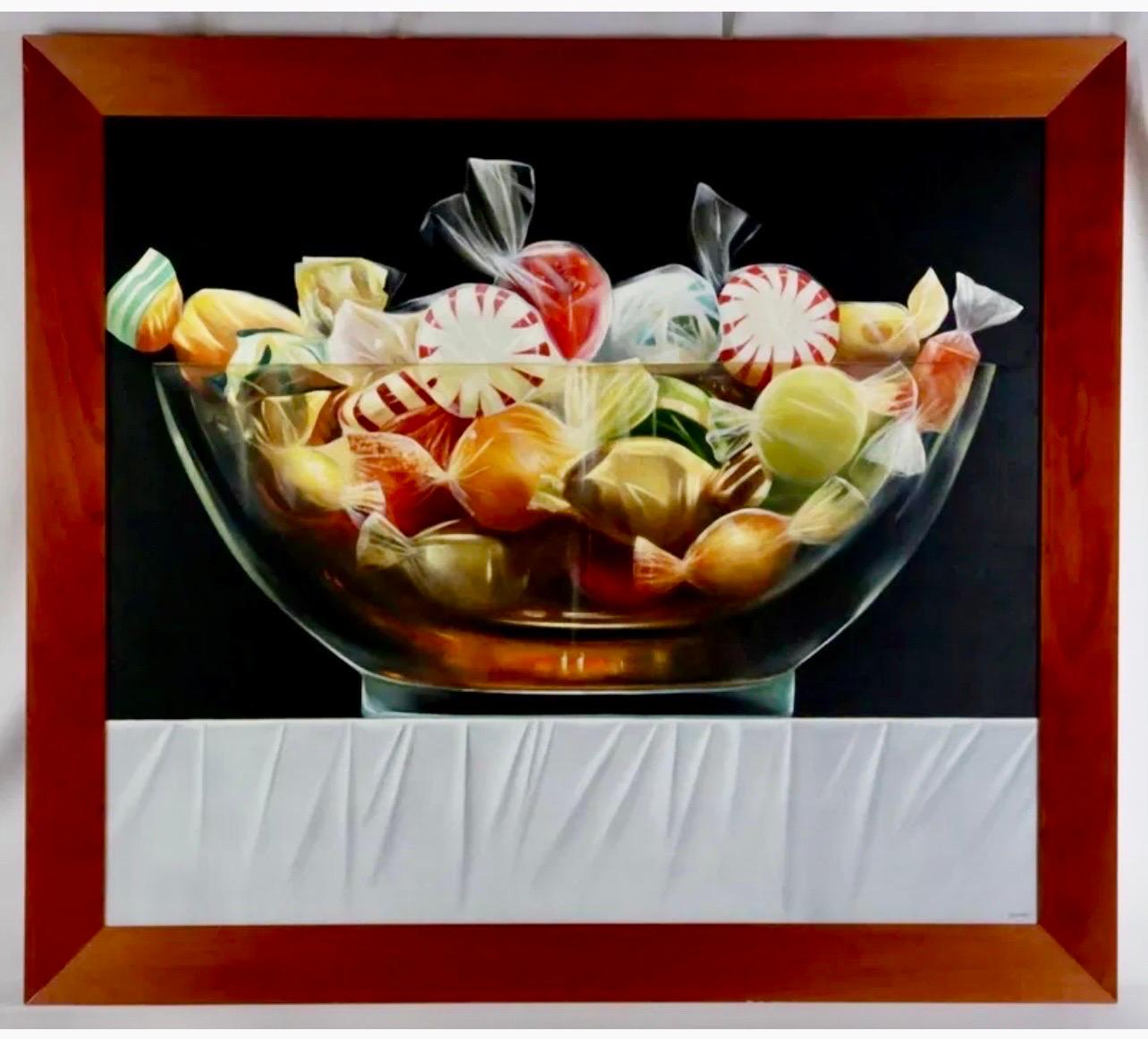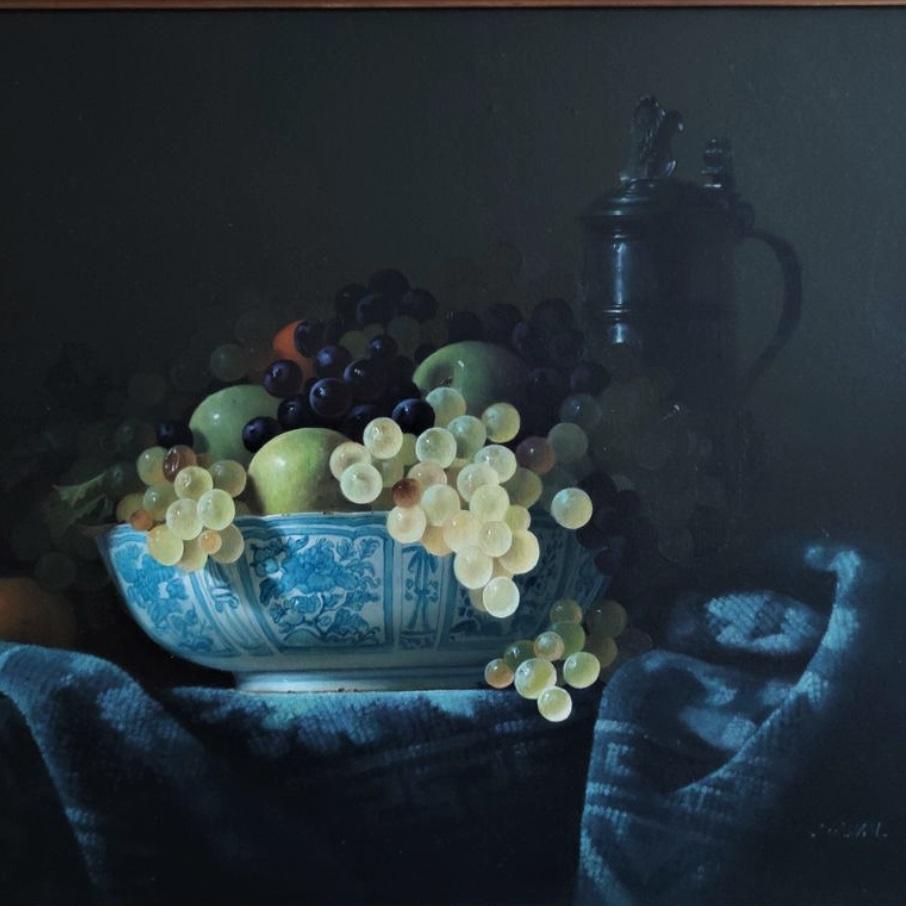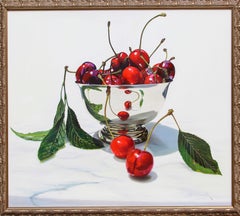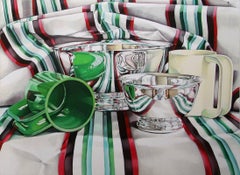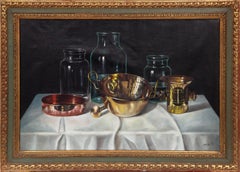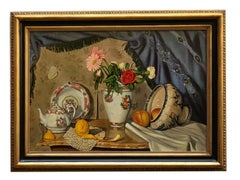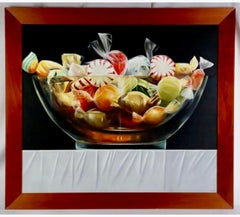Items Similar to The Silver Bowl, Photorealist Oil Painting by Steven Jones
Want more images or videos?
Request additional images or videos from the seller
1 of 6
Steven JonesThe Silver Bowl, Photorealist Oil Painting by Steven Jones2001
2001
$10,500
£7,918.04
€9,157.60
CA$14,731.44
A$16,374.92
CHF 8,583.38
MX$199,977.33
NOK 107,158.54
SEK 100,816.20
DKK 68,349.63
About the Item
Artist: Steven Jones, American
Title: The Silver Bowl
Year: 2001
Medium: Oil on Linen on Panel, signed, titled, and dated verso
Size: 42 x 60 inches
Frame Size: 43.5 x 62 inches
- Creator:Steven Jones (American)
- Creation Year:2001
- Dimensions:Height: 43.5 in (110.49 cm)Width: 62 in (157.48 cm)
- Medium:
- Movement & Style:
- Period:
- Condition:
- Gallery Location:Long Island City, NY
- Reference Number:Seller: RO661111stDibs: LU4661778773
About the Seller
4.9
Platinum Seller
Premium sellers with a 4.7+ rating and 24-hour response times
Established in 1979
1stDibs seller since 2014
3,094 sales on 1stDibs
Typical response time: 1 hour
- ShippingRetrieving quote...Shipping from: Long Island City, NY
- Return Policy
Authenticity Guarantee
In the unlikely event there’s an issue with an item’s authenticity, contact us within 1 year for a full refund. DetailsMoney-Back Guarantee
If your item is not as described, is damaged in transit, or does not arrive, contact us within 7 days for a full refund. Details24-Hour Cancellation
You have a 24-hour grace period in which to reconsider your purchase, with no questions asked.Vetted Professional Sellers
Our world-class sellers must adhere to strict standards for service and quality, maintaining the integrity of our listings.Price-Match Guarantee
If you find that a seller listed the same item for a lower price elsewhere, we’ll match it.Trusted Global Delivery
Our best-in-class carrier network provides specialized shipping options worldwide, including custom delivery.More From This Seller
View AllBowl of Cherries, Photorealist Acrylic Painting by Charles Wildbank
By Charles Wildbank
Located in Long Island City, NY
A bright, photorealistic still-life painting of a silver bowl full of cherries, perched atop a white marble surface. The artist has taken immaculate care to preserve the shiny aspect...
Category
Early 2000s Photorealist Still-life Paintings
Materials
Acrylic
Brass Coffee Grinder and Bowl, Photorealist Oil Painting by Andras Gombar
By Andras Gombar
Located in Long Island City, NY
Artist: Andras Gombar, French (1946 - )
Title: Still Life 1
Year: circa 1965
Medium: Oil on Canvas mounted to Wood, signed
Size: 20 x 24 in. (50.8 x 60.96 cm)
Category
1960s Realist Still-life Paintings
Materials
Canvas, Wood, Oil
Still Life No. 7
By Jeanette Pasin-Sloan
Located in Long Island City, NY
Artist: Jeanette Pasin Sloan
Title: Still Life No. 7
Year: 1979
Medium: Oil on Canvas, signed and dated verso
Size: 46 in. x 62 in. (116.84 cm...
Category
1970s Photorealist Still-life Paintings
Materials
Oil
Vases Still Life, Photorealist Oil on Canvas Painting by András Gombár
By Andras Gombar
Located in Long Island City, NY
A Photorealist Still Life of several metal and glass containers on a covered surface. This oil painting by Andras Gombar is signed in the lower right.
Vases Still Life
András Gombár...
Category
1980s Still-life Paintings
Materials
Oil
$2,250 Sale Price
25% Off
Five Vases, Photorealist Oil Painting on Canvas by Gustavo Schmidt
By Gustavo Schmidt
Located in Long Island City, NY
A Photorealist Still Life painting of five glass vases on a table by Chilean-born artist Gustavo Schmidt.
Five Vases
Gustavo Schmidt, Chilean/American (1963-)
Date: 2012
Oil on Canv...
Category
2010s Photorealist Still-life Paintings
Materials
Canvas, Oil
Vanitas Still Life, Photorealist Oil Painting by Pamela Schermer
Located in Long Island City, NY
Artist: Pamela Schermer, American XXth
Title: Vanitas Still Life
Year: 1986
Medium: Oil on Canvas, signed and dated verso
Size: 36 x 48 inches/ 91 x 122 cm
Category
1980s American Realist Still-life Paintings
Materials
Oil
You May Also Like
Harmony / oil on canvas
By Mimi Jensen
Located in Burlingame, CA
Sophisticated shades of grey and white still life with vases, shell, box and marble. Wonderful complex patterns throughout the oil painting on canvas. In excellent condition. Signed ...
Category
21st Century and Contemporary Photorealist Still-life Paintings
Materials
Canvas, Oil
The Heirloom / oil on linen
By Mimi Jensen
Located in Burlingame, CA
Persimmons, cobalt blue table linens and silver are the focus of this elegant and dramatic still life. Colors include silver, orange and blue. Photorealist oil painting on canvas. T...
Category
21st Century and Contemporary Photorealist Still-life Paintings
Materials
Canvas, Linen, Oil
STILL LIFE - Hyper - Realistic - Oil on Canvas Italian Painting
By Maximilian Ciccone
Located in Napoli, IT
Stil life Maximilian Ciccone Italia 2011 Oil on canvas mis. cm. 60x90.
This oil on canvas painting is an incredible example of the artist's ability to capture breathtaking detail a...
Category
2010s Realist Still-life Paintings
Materials
Canvas, Oil
Original James Tormey Photo Realist Oil Painting Still Life Candy Bowl Pop Art
Located in Surfside, FL
James Tormey (American, 1938-2017)
"Candyland (Mixed Bowl)" on table with white tablecloth cover.
Oil Painting on Canvas.
Hand signed lower right.
Measures approx. - 32" high x 37" wide, total with frame - 37 1/2" high x 42 1/2" wide.
James J Tormey, NYC artist, He was born in Brooklyn in 1938. As a young man he moved to Manhattan where he lived and worked for more than 60 years. James Tormey studied at the Pratt Institute, in Brooklyn, and at Columbia University and worked in advertising for several years while he painted part time. In the 1960s he supported himself as a photographer, covering openings and events for the Museum of Modern Art, in New York City. For many years he was represented by the Madison Avenue Gallery, in New York City, where he had numerous one-man shows. He has also exhibited in Japan and Germany. The artist makes his home in Manhattan and is represented by the Uptown Gallery, also in New York City. James Tormey paints still lifes of traditional subject matter: fruit, vegetables, or eggs appear in bowls or on surfaces illuminated by powerful directional light. Tormey builds stronger and more precise meaning into his work by exploring how the backgrounds and settings for his still lifes can convey particular ideas. In his recent work, for instance, he painted a series of images in which fruit—a traditional still-life subject—is placed in architectural settings or frames that we usually associate with religious imagery. In Icon, for instance, the artist painted a red cabbage and placed it inside a Renaissance-style frame that he built and decorated himself. Instead of being presented with a saint or a Madonna within such a context, we are given a fully realized, but quite ordinary, vegetable.
Tormey’s painting technique involves great care from the beginning. He works in his apartment in Manhattan’s Upper West Side in a meticulously clean space equipped with a very solid easel and a large glass palette on a painting table. For reference he uses photographs he has taken of still-life setups in conjunction with pictures of architectural or other settings he has collected over the years. “I start with a careful graphite drawing right on the canvas,” he explains. These days he uses lightweight cotton duck, although much of his earlier work was done on smoother surfaces. Once the graphite line is established, the artist makes a thin monochrome version of the image with a dull green. “I don’t add anything to the paint other than turpentine,” he explains. “I don’t use oil or glazing mediums because I don’t like shine. The turpentine dulls the paint, which suits what I’m doing.” Once the green layer has dried, the artist applies a second thin layer in a warm brown using burnt sienna or burnt umber. “In all these stages I’m working from dark to light,” he says, “so that I’m always getting a rendered, three-dimensional image.” Tormey works on two or three paintings at a time to allow for sufficient drying time between layers. “I also like the way one painting seems to talk to another,” he says. “It makes for a richer process.” Once he starts working in full color on the image, he continues slowly, applying many thin layers and gradually achieving subtle tonal and color shifts until his forms burst with three-dimensional life. “I work with a very dry brush,” explains the artist. Many of Tormey’s paintings contain dark backgrounds, some of which are pure black—something that can present its own technical problems. “I don’t want those backgrounds to feel present,” he says. “I want them to simply drop out.”
Because he doesn’t want any shine on his work he doesn’t use varnish. It’s not surprising that Tormey’s work, with its heavy contrasts and smooth tonal transitions, is strongly influenced by photography. Tormey worked as a photographer for some years, and when he began doing still lifes he often photographed them against black backgrounds.
His work was also published as fine art cards, posters, and fine art Giclee prints. He pioneered the "larger-than-life" still-life with his work combining traditional subject matter with a contemporary interpretation that produces startling images of heroic proportions. Light reflected and transmitted lends the natural objects, which are the subjects, a quality which may evoke in the viewer clarity of vision and a delight in the forms of the natural world around them. His work conveys a powerful positive philosophy and he once said "I believe the only way we can come to terms with the world is if we look at it as it really is." He believed that artists should take responsibility for the meaning their works carry and stated that "there are definite ideas behind my paintings". He studied at Pratt Institute and Columbia University and worked in advertising and as a photographer before turning to full-time painting.
His paintings were exhibited in dozens of galleries around the country, in Germany and Japan and are now seen in numerous public and private collections.
While he was not officially part of the Photorealism art...
Category
20th Century Photorealist Still-life Paintings
Materials
Canvas, Oil
Still life with a Chinese bowl by Jean Grimal
By Jean Grimal
Located in Gent, VOV
Jean Grimal is a true 20th century discovery. This breathtaking piece is a gorgeous example of his mastery as an artist. He beautifully creates chiaroscuro in this painting. The way the light touches the edges of the Chinese bowl and the grapes is an example of his skill in representing light.
Jean Grimal (1942-1998) was born in the town of Tulle, France in 1942. Jean’s family moved to Paris when he was 8 years of age. After receiving a classical French education with studies in Latin and Greek, Jean Grimal entered the University to receive his Baccalaureate. He then attended Claude Barnard School for three years, when he received his Art Degree. Upon completion Grimal taught art for seven years. As Grimal’s own interest in formal painting and art began to possess him, the artist’s destiny changed.
In 1967 Jean Grimal stepped aside from teaching and pursued a career in professional painting and working as an illustrator in advertising. As an advertising illustrator, Grimal worked with Lise Goldfard for more than 25 years at Studio 44 where they collaborated with major and important accounts, such as: Air France, Christofle, Peugeot, Lacoste, to name a few. At the same time he began presenting his formal paintings to galleries in Paris and Cannes, France and in London and Windsor, England. Much to his surprise, Grimal found that his paintings were sought after by major art galleries and collectors throughout Europe. After a number of years of being an important and successful art illustrator for these major accounts, he found himself having to choose between the two. Fortunately for collectors, he chose to dedicate his life to the classical style of painting. Jean looked at the simplest things in life through a microscope, where he could take the simplest object and depict the age of the fruit or the leaf.
Jean Grimal received great pleasure from his work and painted for over thirty years. As his style matured and became ever more perfect Jean Grimal truly reached the pinnacle of his career. The artist’s methods were particularly distinguished when measured against his peers. Grimal’s painting skill was distinctive and exceptional.
Jean Grimal was known for his realistic trompe l’oeil and still life paintings. The artist would carefully arrange the objects to form a satisfying composition. By painting every shadow, highlight, and reflection within each composition Grimal brought mundane subjects to life. His tight rendering combined with his attention to light and detail allowed him to blur the lines between illusion and reality, truly making his works one of a kind. Grimal’s trompe l’oeil paintings consist of intricate compositions of cards, envelopes, photographs, paper of different materials and weights, backs of canvases, images of other artists’ works, kitchen utensils, pistols, and more. Grimal had a talent for mastering these illusions that deceive the eye in his trompe l’oeil paintings.
No matter what genre Grimal was painting, tight, unperceivable brushwork characterizes his work. The artist painted every crease and crinkle, every shadow and highlight, every detail. By doing so, he was able to capture each individual surface texture of the objects in his paintings. Grimal was also fabulous at depicting light in his paintings- often contrasting strong lights with strong darks, creating chiaroscuro modeling.
His still life paintings are reminiscent of Dutch seventeenth century...
Category
Late 20th Century Realist Still-life Paintings
Materials
Canvas, Oil
Focus, Oil Painting
Located in San Francisco, CA
Artist Comments
"Being a single father and working a full-time job limits the time I have to paint," shares artist Christopher Garvey. "This...
Category
21st Century and Contemporary American Realist Still-life Paintings
Materials
Oil
More Ways To Browse
18th Century Primitive Still Life Paintings
A Lester Gaba
A M Gorter
Alice Mary Burton On Sale
Amy Nelder
Cartier Cubist Clock
Cornelia Hernes
Cornelis Van Spaendonck
Dennis Assayac
Desire Alfred Magne
Donald Werden
Dorothy Lampl
Elizabeth Campbell Fisher Clay
Emma Richardson Cherry
Esther Boyd
Fujiko Rose
Gregory Hull
Hall Groat
